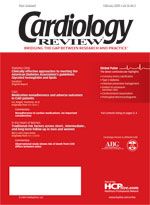Revisiting the silent killer in Asian Indians
While reviewing the American Heart Association (AHA) 2008 Clinical Perspectives in the January 2009 issue of Cardiology Review, especially the article by Dr Ferdinand regarding African American beliefs and adherence to antihypertensive medications, it dawned upon me that a review of articles and data on hypertension in Asian Indians is also warranted, as this population is often overlooked.
While reviewing the American Heart Association (AHA) 2008 Clinical Perspectives in the January 2009 issue of Cardiology Review, especially the article by Dr Ferdinand regarding African American beliefs and adherence to antihypertensive medications, it dawned upon me that a review of articles and data on hypertension in Asian Indians is also warranted, as this population is often overlooked. In an article coauthored by Dr Mukherjee in Current Hypertension Reviews, the authors conclude that aggressive screening and treatment should be adopted in Asian Indians.1 They also indicate that specific guidelines for the treatment of hypertension in this population are warranted. While delving into the facts and figures of hypertension in Asian Indians, I came across some astounding data.
According to a statistical fact sheet from 2007 issued by the AHA, compared with data from 2000, the number of years of productive life lost to cardiovascular disease will have increased in 2030 by 20% in the United States, 30% in Portugal, 57% in China, 64% in Brazil, and an alarmingly high 95% in India.2 Cardiovascular diseases caused 2.3 million deaths in India in 1990, and this number is projected to double by 2020.3 Hypertension is directly responsible for 57% of all stroke deaths and 24% of all coronary artery disease deaths in India. According to a recent review on the “global burden of hypertension,” the estimated prevalence of this disorder in individuals aged 20 years and older in India in 2000 was 20.6% for men and 20.9% for women, and these numbers are projected to increase to 22.9% and 23.6%, respectively, by 2025.4 The estimated total number of people with hypertension in India in 2000 was 118.2 million (60.4 million men and 57.8 million women), which is projected to increase to 213.5 million (107.3 million men and 106.2 million women) by 2025.
Although these hypertension rates may be partially related to increased sodium intake and reduced physical activity, a recent article reported that an angiotensin-converting enzyme (ACE) gene insertion/deletion polymorphism could be a potential genetic risk factor for developing hypertension.5 The authors of this study observed that the odds of being hypertensive were 7.483 (95% confidence interval, 1.746-30.192) in D/D individuals compared with those carrying 1 or no D alleles. This finding suggests that ACE insertion/deletion polymorphism is associated with essential hypertension in Asian Indians. Moreover, individuals who are homozygous for the D allele of the ACE gene are more likely to have essential hypertension.
Clinicians could use the Indian Hypertension Guidelines-II as a guide for treating Asian Indians in the United States.4 These guidelines were released by the Indian prime minister, Atal Behari Vajpayee, and have been endorsed by the Cardiology Society of India, the Hypertension Society of India, the Indian College of Physicians, and the Association of Physicians of India. Although Indian experts had previously modified some of the World Health Organization’s (WHOs) hypertension guidelines that were released in 1999, this was the first time that guidelines have been formulated for a disease state by an expert body of Indian doctors.
Unlike the WHO guidelines, which recommend starting treatment in low-risk hypertension cases 6 to 12 months after initial observation and in medium-risk cases 6 months thereafter, the Indian guidelines recommend starting treatment 3 months after initial observation for both low- and medium-risk cases. “Waiting for so long after seeing a patient with hypertension did not make sense to us,” noted Dr Gurpreet Wander, a member of the panel that formulated the guidelines, in an article published in the British Medical Journal.6
The Indian guidelines emphasize avoidance of processed foods, pickles, chips, and certain Indian food items, such as poppadums and chutneys. They also recommend reduced intake of ghee (clarified butter) and advocate yoga and meditation. Whereas the WHO guidelines suggest that 6 classes of drugs are equally effective as a first-line treatment, the Indian guidelines give extra weight to low-dose diuretics and beta blockers. Use of fixed-dose formulations is discouraged. “Due to greater seasonal variation of temperature in India and lesser body surface area of our population, marginal alterations in dosages of drugs may be needed from time to time,” noted Dr Wander.6
Future physicians should focus on invoking interest in their patients regarding the care of the human frame through lifestyle modification, stress-relieving techniques, adherence to healthy diets, and exercise alongside medical management. Only with these efforts can we make a stride in our battle against hypertension, the silent killer.
The doctor of the future will give no medicine but will interest his patients in the care of the human frame, in diet, and in the cause and prevention of disease. —Thomas Edison
